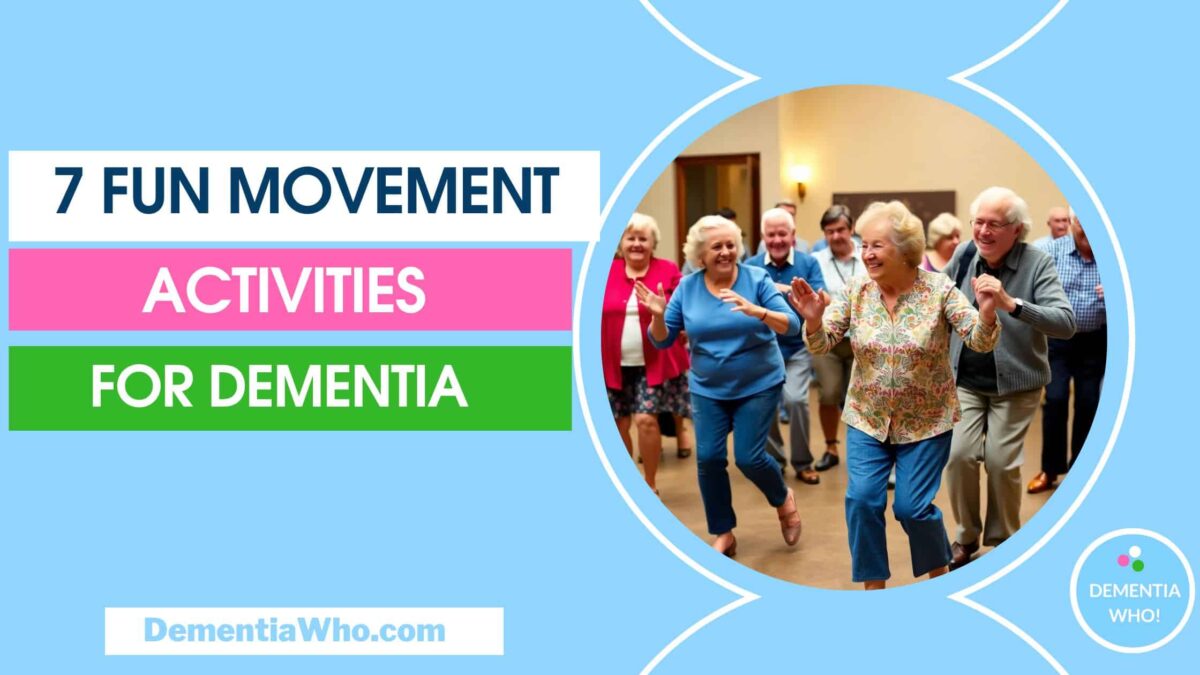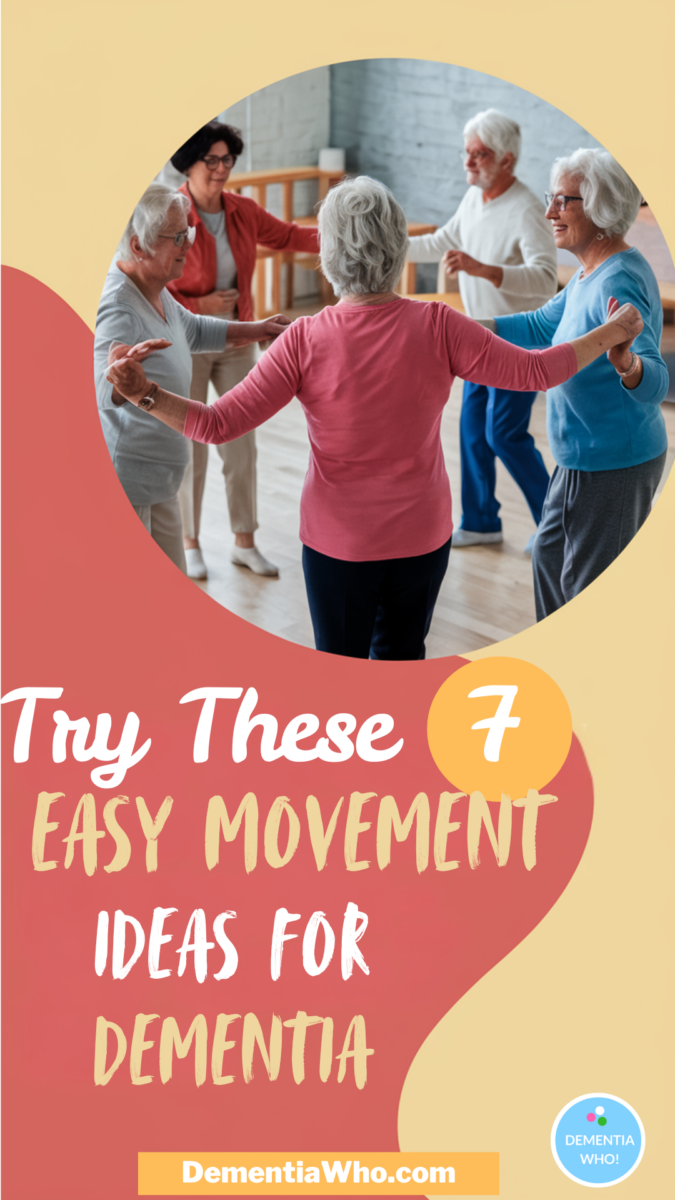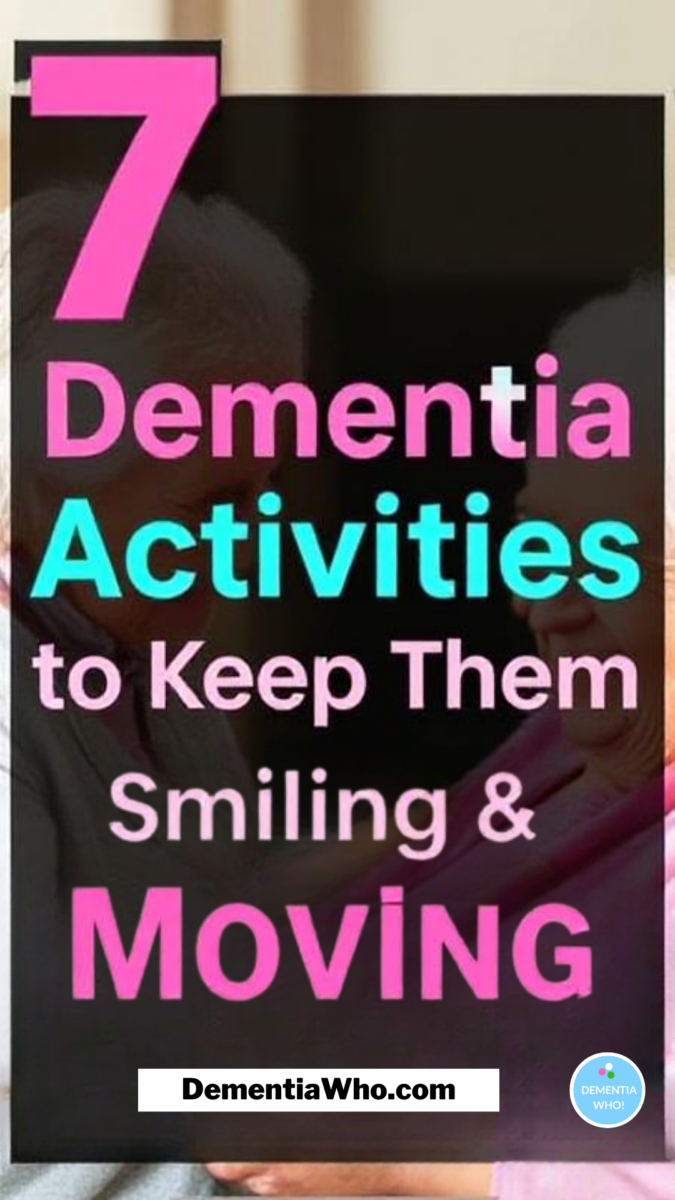I know as a dementia caregiver how hard it is find activities that can be fun and improve physical and mental well being. You may be searching for movement activities for dementia that that brighten your loved ones day, well check out the suggestions below for some fun ideas.
7 Movement Activities for Dementia
This article will hopefully give you ideas on 7 Movement Activities for Dementia: Dance, Stretch and Smile that are safe, fun and accessible for everyone.

1. Dance Parties for Expression
Description:
Dance is a magical way to connect through music and movement. Before mobility issues, we used to invite friends around and have a dance party or just put some music on just for us. We could clap, dance or just sway to the music listening to our favourite tunes. Imagine formal dances or traditional dances being done with your loved one or performed for them. You can try really simple dance routines that can be tailored to various abilities so everyone feels included, making it an activity for all skill levels.
All You’ll Need Is:
- Simple and accessible playlist of upbeat songs or favorite tunes.
- Decorations to brighten up the space, such as streamers or balloons.
- Optional: Comfortable chairs for seated participation.
Benefits:
These dance parties can be great to improve mood, encourage creative self-expression, and improve physical stamina. They also strengthen social bonds, fostering connection through shared laughter and movement.
Safety Concerns:
Ensure the area is free of clutter to prevent trips or falls. If your loved one is unsteady on their feet, encourage them to dance seated or hold onto a sturdy surface for support.
2. Balloon Toss for Coordination and Fun
Description:
You can try so many variations of balloon games, they’re great for adding a playful element to movement activities, combining physical coordination with light-hearted competition. Tossing and catching colorful balloons can help with stretching and moving arms in a natural and enjoyable way.
All You’ll Need is:
- Brightly colored balloons.
- Optional: Light background music to enhance the fun.
Benefits:
Balloon toss games can stimulate hand-eye coordination and help with arm mobility. It’s a social activity too, encouraging conversation and teamwork.
Safety Concerns:
Supervise to ensure that participants don’t overreach or lose balance while playing. Before you start make sure there aren’t any issues with mobility or existing shoulder and arms issues.

3. Nature Walks with Mindfulness Techniques
Description:
I loved walking and don’t do it often enough. You can find some community groups that offer walks as part of programme of mental health tools, to meet and connect with others and a chance to improve overall health though gentle excercise. They incorporate mindfulness techniques, so you get the opportuntiy to pause, and feel the soothing effects of nature, take deep breaths, and take time for moments of reflection or just connect with what’s around you.
All You’ll Need Is:
- Comfortable walking shoes.
- A quiet and accessible outdoor location like a park or garden.
Benefits:
Nature walks help reduce stress levels, improve mood, and stimulate cognitive engagement by encouraging participants to observe their environment. If you’re practicing mindfulness techniques, you’ll enhance the benefits you get from a walk on your stress levels and mental health.
Safety Concerns:
Choose routes with smooth, even paths to avoid tripping hazards. Keep walks short and include rest stops if needed to prevent fatigue.
4. Chair Yoga for Gentle Movement
Description:
Chair yoga introduces a low-impact form of movement that is accessible to most, even those with limited mobility. You can remain seated to stretch your arms, twist gently, or flex your legs. It’s a great way to get a little bit of exercise in. You can join local exercise groups or use YouTube videos to do this at home.
All You’ll Need Is:
- Sturdy chairs without wheels.
- Light background music (optional).
Benefits:
Chair yoga enhances flexibility, boosts circulation, and reduces stiffness in muscles and joints. It also encourages relaxation, can help improve sleep by promoting an overall sense of well-being.
Safety Concerns:
Ensure that chairs are on a non-slip surface to prevent movement. Guide participants through gentle stretches to avoid overexertion.

5. Creative Movement with Scarves
Description:
Maybe it’s a generational thing, but my mum has a ton of colourful scarves around the home. We decided to add them into our gentle movements with music, the feel and textures combined with the musical element really adds to the enjoyment for loved ones with dementia. Even towards the end when movement was limited, performing for mum waving and twirling with the scarves, or brushing silk scarves against her skin all added to her enjoyment.
All You’ll Need is:
- Lightweight, brightly colored scarves.
- A playlist of soft or upbeat music.
Benefits:
This activity improves motor skills and coordination while fostering imaginative expression. The flowing motions and vibrant colors create engaging visual stimulation, making it enjoyable and soothing at the same time.
Safety Concerns:
Avoid scarves with long strings or sharp edges. Encourage slower, deliberate movements to maintain a safe pace.
6. Rhythmic Sound and Movement Sessions
Description:
Music-based activities with rhythm and sound are fantastic for engaging the body and mind. You can try tapping tambourines, shake maracas, use mini drums or clap along to the beat of songs. You choose what works for you, and anything goes, whatever type of movement naturally flows from that rhythm, whether it’s swaying, stepping, or tapping feet.
All You’ll Need Is:
- Simple musical instruments such as handheld drums, tambourines, or shakers.
- Playlist of cheerful, rhythmic music.
Benefits:
Rhythmic activities stimulate cognitive function, encourage physical activity, and strengthen a sense of rhythm. They’re also highly interactive, creating opportunities for shared joy.
Safety Concerns
Choose lightweight, easy-to-hold instruments. Keep an eye out to ensure they’re comfortable with the movements and pace.
7. Artistic Movement with Paint and Canvas
Description:
Painting is not only a creative outlet but it can be a movement exercise when using large canvases. Your loved ones with dementia can sit or stand as they use brushes to stretch their arms and create designs on a canvas or large sheet of paper. If you’ve ever tried painting on a large canvas, you’ll realise it’s a completely different experience. I’d encourage your loved one to go with what feels right to them, they’re isn’t a right or wrong way, you can paint on easel, with the canvas on the floor, throw paints onto it or use tools to create an original artwork.
All You’ll Need Is:
- Paints and brushes in various sizes.
- Blank canvases, paper, or a flat paint-friendly surface.
- Smocks or aprons to prevent staining clothes.
Benefits:
This combination of art and gentle physical activity encourages relaxation and self-expression while helping to maintain upper body mobility. Social interactions during group painting sessions also enhance engagement and bonding among participants.
Safety Concerns:
Use non-toxic paints and avoid sharp or heavy tools. Protect the work area from spills to prevent slipping hazards.
Conclusion
There are so many ways that you can engage in meaningful movement activities, it doesn’t have to be all exercise related. It’s looking at a particular hobby or activity your loved ones likes to do and reinventing it in a way that encourages more movement. Whether it’s dancing to familiar songs, exploring the beauty of nature, or creating art together, these activities deliver much more than just physical benefits. They hopefully bring laughter, a wee smile, and pure enjoyment.
Why not try to add a few into your daily routine—they may be just what you and your loved one need to brighten your days together.


